艺术设计专业英语Unit 3 First Step in Making Your Ideas
- 格式:pptx
- 大小:1.54 MB
- 文档页数:15
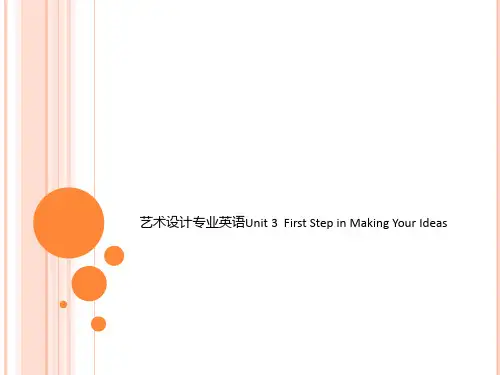


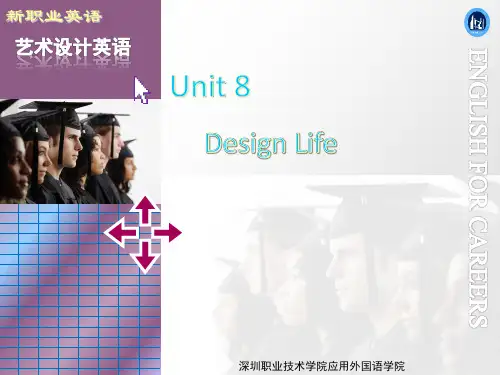
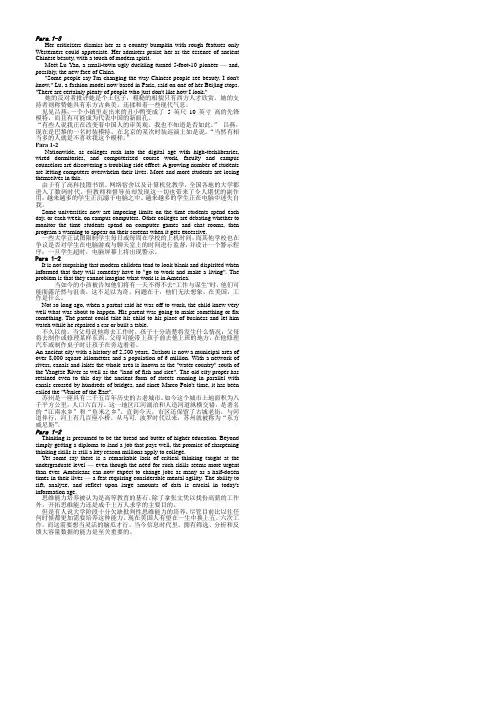
Para.1-3Her criticizers dismiss her as a country bumpkin with rough features only Westerners could appreciate. Her admirers praise her as the essence of ancient Chinese beauty, with a touch of modern spirit.Meet Lu Yan, a small-town ugly duckling turned 5-foot-10 pioneer — and, possibly, the new face of China."Some people say I'm changing the way Chinese people see beauty. I don't know," Lu, a fashion model now based in Paris, said on one of her Beijing stops. "There are certainly plenty of people who just don't like how I look."她的反对者批评她是个土包子,粗糙的相貌只有西方人才欣赏。
她的支持者则称赞她具有东方古典美,还揉和着一些现代气息。
见见吕燕,一个小镇里走出来的丑小鸭变成了 5 英尺10 英寸高的先锋模特,而且有可能成为代表中国的新面孔。
“有些人说我正在改变着中国人的审美观。
我也不知道是否如此。
”吕燕,现在是巴黎的一名时装模特,在北京的某次时装巡演上如是说。
“当然有相当多的人就是不喜欢我这个模样。
”Para 1-2Nationwide, as colleges rush into the digital age with high-techlibraries, wired dormitories, and computerized course work, faculty and campus counselors are discovering a troubling side effect: A growing number of students are letting computers overwhelm their lives. More and more students are losing themselves in this.由于有了高科技图书馆、网络宿舍以及计算机化教学,全国各地的大学都进入了数码时代。


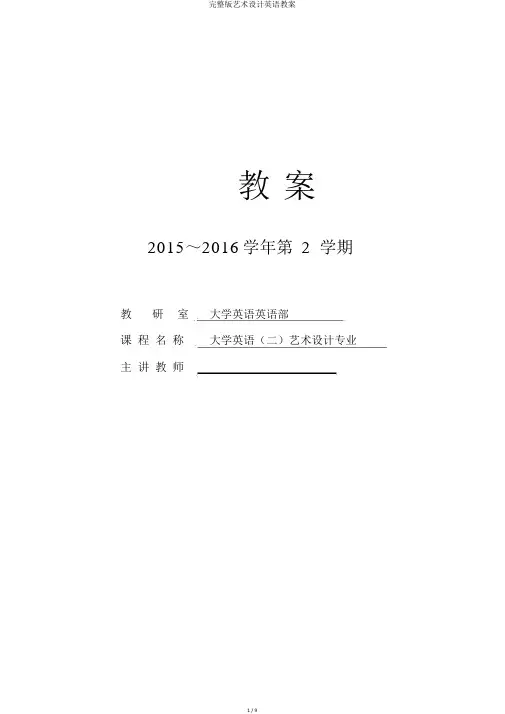
教案2015~2016学年第2学期教研室大学英语英语部课程名称大学英语(二)艺术设计专业主讲教师讲解章节复习语法知识:定语从句、句子结构授课时数 2 periods第一周授课目标:掌握定语从句的基本知识掌握句子成分,会解析句子结构。
教学内容(讲解大纲)本章节的授课重点、难点:Make sure that students understand⑴ the theme(purpose behind the text);⑵the important things that the text contains for the readers to think about;授课方法、授课手段:Open questions and answers in classPPT and multimedia作业:Find the information about The arts & Crafts Movement参照资料:点击职业英语(艺术设计篇)、王道真语法授课反思:讲解章节Unit 4 Graphic Design授课时数 2 periods第二周授课目标:1、完成听力练习。
2、认识工艺美术运动的背景知识。
教学内容(讲解大纲)本章节的授课重点、难点:授课方法、授课手段:Open questions and answers in classPPT and multimedia作业:Preview the text参照资料:点击职业英语(艺术设计篇)、王道真语法授课反思:讲解章节Unit4 Graphic Design平面设计授课时数 3 periods第三周-第四周第一小节授课目标:Grasp the theme of the textAnalysis the text (main idea, structure)Learn more about the background教学内容(讲解大纲)I.lead-in questions:What is Arts & Crafts Movement?检查两位同学作业,老师总结。
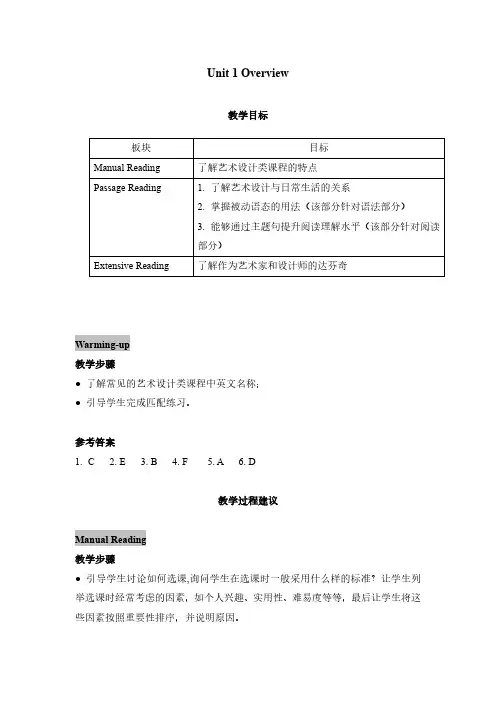
Unit 1 Overview教学目标Warming-up教学步骤●了解常见的艺术设计类课程中英文名称;●引导学生完成匹配练习。
参考答案1. C2. E3. B4. F5. A6. D教学过程建议Manual Reading教学步骤●引导学生讨论如何选课,询问学生在选课时一般采用什么样的标准?让学生列举选课时经常考虑的因素,如个人兴趣、实用性、难易度等等,最后让学生将这些因素按照重要性排序,并说明原因。
●引导学生熟悉课程介绍类文本的特点、组成部分;●引导学生熟悉本部分的生词和词组;●引导学生阅读本部分课程说明并组织学生讨论对这门课程的理解;●引导学生完成课后练习。
课文译文课程说明:艺术设计基础概述本课程的目标是从绘图和绘画的基础着手,帮助学生提高艺术基本功。
在本课程,每个人都能根据自己的实际需求、个人意愿和具体方向决定并订制课程内容。
本课程设计实用、趣味性强,课程将帮助每位学员培养艺术设计技能并构建学习发展档案。
学员将广泛探索各项基础技能,试验技巧和流程。
通过不同艺术媒介的运用,每位学员都能在完成项目工作的同时形成自己独特的创作风格。
招生和学习模式年度招生人数:20名学生上课时间:每周五上午10:30至下午1:30(九月)您也可以在方便的时候在网上学习本课程。
主要模块入学要求学员在开课第一天时必须年满15岁。
本课程将全程用英语授课。
练习答案Task 11. typical modules2. at least 15 years of age3. a portfolio of work4. basics5. OnlineTask 21. module2. sketch3. portfolio4. intake5. tailorPassage Reading教学步骤●引导学生思考设计对我们的生活带来了什么影响,并要求学生举例说明;●引导学生熟悉本部分的生词与词组;●引导学生阅读理解课文,并从自己专业的角度讨论什么样的设计是好的设计;好的设计有怎样的特点;如何完成一个好的设计。
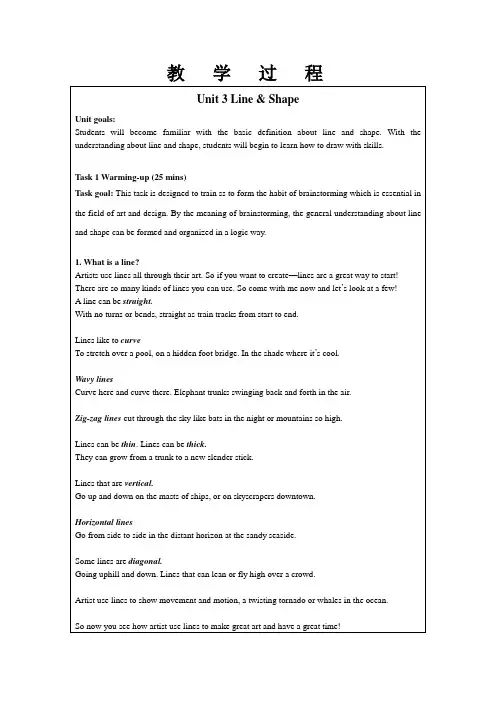
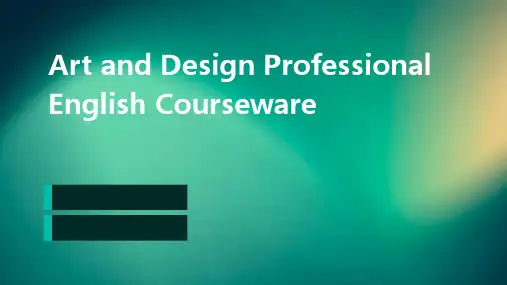
艺术设计英语unit3designdefinitionDesign is a broad and multifaceted field that involves the creation and development of various visual and functional solutions. It combines creativity, problem-solving skills, and technical knowledge to produce designs that meet specific objectives.1. Definition of Design:Design can be defined as the process of creating and shaping something that is aesthetically appealing, functional, and purposeful. It involves the use of different elements such as lines, shapes, colors, textures, and patterns to communicate an idea or message effectively. Design can be seen in various forms, including graphic design, industrial design, interior design, fashion design, and architectural design.2. Purpose of Design:The purpose of design is to solve problems and meet specific needs. Designers analyze the requirements, constraints, and objectives of a project, and then use their expertise and creativity to develop visual or functional solutions. The goal is to create designs that are not only visually pleasing but also efficient, user-friendly, and marketable.3. Elements of Design:The elements of design are the building blocks that designers useto create visually appealing compositions. They include:- Line: Lines can be used to create different effects and convey different emotions. They can be straight, curved, thick, thin, horizontal, vertical, or diagonal.- Shape: Shapes are created by enclosing lines and can be organic or geometric. They provide structure and form to a design.- Color: Colors have the power to evoke emotions and moods. Designers use the color wheel to choose harmonious combinations and create visual interest.- Texture: Texture adds depth and tactility to a design. It can be actual (tangible) or implied (visual).- Pattern: Patterns are the repetition of elements such as shapes, lines, or colors. They add visual interest and rhythm to a design.- Space: Space refers to the area within and around design elements. It can be positive (occupied) or negative (empty). Proper use of space is crucial for achieving visual balance.4. Principles of Design:The principles of design provide guidelines for organizing and arranging the elements. They include:- Balance: Balance refers to the distribution of visual weight in a design. It can be symmetrical (formal), asymmetrical (informal), or radial.- Proportion: Proportion is the relationship between the sizes of different elements. It helps create a sense of harmony and prevents visual confusion.- Unity: Unity refers to the coherence and consistency of a design. It involves using similar elements and principles throughout the composition.- Contrast: Contrast is the juxtaposition of different elements to create visual interest. It can be achieved through contrasting colors, sizes, shapes, or textures.- Emphasis: Emphasis is used to draw attention to a specificelement or area in a design. It can be achieved through contrast, size, placement, or color.- Movement: Movement creates a sense of visual flow and directs the viewer's eye through the design. It can be achieved through the arrangement of elements and the use of lines and shapes.- Rhythm: Rhythm refers to the repetition or alternation of elements to create a sense of organized movement. It can be regular, flowing, progressive, or random.5. Design Process:The design process is a systematic approach followed by designers to create effective solutions. It typically involves the following steps:- Define the problem: Identify the objectives, constraints, and target audience of the project.- Research and brainstorm: Gather information, explore different ideas, and generate potential solutions.- Sketch and prototype: Create rough drawings and physical or digital prototypes to visualize and test ideas.- Refine: Select the most promising concepts and refine them further through iterations and feedback.- Finalize: Develop the chosen design concept into a polished, finished product.- Evaluate: Test and evaluate the design, making any necessary modifications or improvements.In conclusion, design is an expansive field that encompasses various disciplines and involves creative problem-solving. It utilizes different elements and principles to create visuallyappealing and functional solutions. The design process is a systematic approach that ensures the development of effective and successful designs.。
《艺术设计英语》教学教案(一)章节名称:艺术设计概述教学目标:1. 了解艺术设计的定义和分类;2. 掌握艺术设计的基本原则和方法;3. 能够运用英语描述和分析艺术设计作品。
教学内容:1. 艺术设计的定义和分类;2. 艺术设计的基本原则和方法;3. 艺术设计作品的分析和描述。
教学步骤:1. 引入:通过展示一些艺术设计作品,引发学生对艺术设计的兴趣和好奇心;2. 讲解:讲解艺术设计的定义和分类,介绍艺术设计的基本原则和方法;3. 实践:学生分组讨论,分析一些艺术设计作品,并尝试用英语进行描述和分析;教学评价:1. 观察学生在讨论中的表现,了解他们对于艺术设计的理解和掌握程度;2. 收集学生的描述和分析作品,评价他们的英语表达能力和对艺术设计的理解。
《艺术设计英语》教学教案(二)章节名称:平面设计教学目标:1. 了解平面设计的定义和分类;2. 掌握平面设计的基本原则和方法;3. 能够运用英语描述和分析平面设计作品。
教学内容:1. 平面设计的定义和分类;2. 平面设计的基本原则和方法;3. 平面设计作品的分析和描述。
教学步骤:1. 引入:通过展示一些平面设计作品,引发学生对平面设计的兴趣和好奇心;2. 讲解:讲解平面设计的定义和分类,介绍平面设计的基本原则和方法;3. 实践:学生分组讨论,分析一些平面设计作品,并尝试用英语进行描述和分析;教学评价:1. 观察学生在讨论中的表现,了解他们对于平面设计的理解和掌握程度;2. 收集学生的描述和分析作品,评价他们的英语表达能力和对平面设计的理解。
《艺术设计英语》教学教案(三)章节名称:立体设计教学目标:1. 了解立体设计的定义和分类;2. 掌握立体设计的基本原则和方法;3. 能够运用英语描述和分析立体设计作品。
教学内容:1. 立体设计的定义和分类;2. 立体设计的基本原则和方法;3. 立体设计作品的分析和描述。
教学步骤:1. 引入:通过展示一些立体设计作品,引发学生对立体设计的兴趣和好奇心;2. 讲解:讲解立体设计的定义和分类,介绍立体设计的基本原则和方法;3. 实践:学生分组讨论,分析一些立体设计作品,并尝试用英语进行描述和分析;教学评价:1. 观察学生在讨论中的表现,了解他们对于立体设计的理解和掌握程度;2. 收集学生的描述和分析作品,评价他们的英语表达能力和对立体设计的理解。